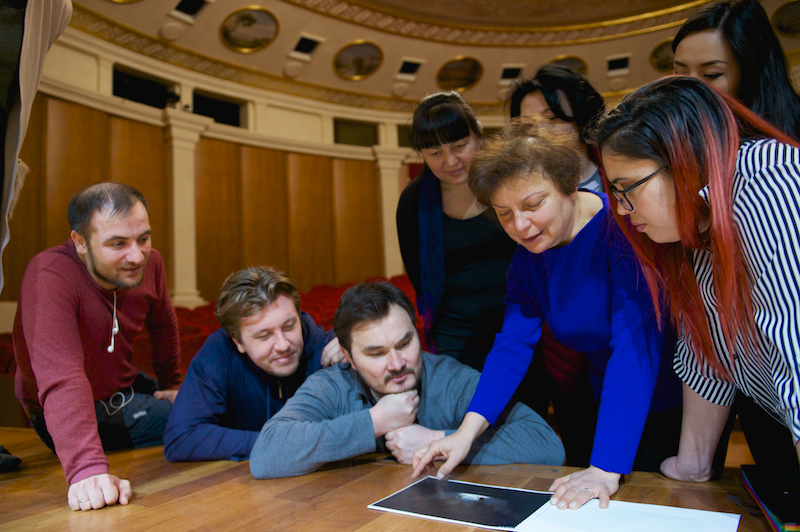The Opera La Scala di Seta Will Open the Astana Opera’s New Project
Sparkling humor, enthusiasm and ingenuity of young artists, virtuosity of vocal and instrumental parts – all this awaits the Astana Opera’s audience at the premiere of Rossini’s opera La Scala di Seta in the Piccolo Chamber Theatre. The performance will be held with the support of the Ministry of Culture and Sports of the Republic of Kazakhstan within the framework of the Year of Youth on April 6 and 7.
Today, this opera is staged quite rarely in the world, and it is almost impossible to listen to it in Central Asia. In just three years, twenty-year-old Rossini composed five comedic operas: La Cambiale di Matrimonio, L’Inganno Felice, La Scala di Seta, L’Occasione Fa il Ladro and Il Signor Bruschino.
The opera will take listeners to the 18th century. Giulia will secretly marry her beloved Dorvil. In order to get to his wife, he uses a silken ladder, which she lowers down to him from her window. Giulia’s guardian, old Dormont, unaware of her marriage, will try to marry her off to Blansac, Dorvil’s womanizer friend. Performers and production team talk about what happens.
Music Director and Conductor Abzal Mukhitdinov noted that, despite the rather extensive score, the musicians easily master it.
“Rossini wrote this opera as a young man, and La Scala di Seta became a springboard to his fame. At that time, Rossini collaborated with the Venetian Teatro San Moisè, which specialized in the production of farces – one-act comic operas. All of composer’s music, young and playful, is the main distinguishing feature of his writing style. In his early operas, ‘long Rossini crescendos’ have become, in modern terms, a brand that we will later hear in almost all of his operas, including Il Barbiere di Siviglia,” the maestro explained.
“Today, the singers who truly master the technique of coloratura vocals are very rare. In our case, besides soprano, it is a baritone, a tenor, a bass, and even a mezzo-soprano! We are happy that there are specially trained artists in our opera house. Some of them studied in Pesaro, the city where Rossini was born, and at the Accademia Lirica Osimo. In addition, the Director of the production Ala Simonishvili (Italy) is a professor at the Accademia Lirica Osimo. Thus, we get Rossini style first-hand. In addition, in this opera, the composition of the orchestra is very unusual from today’s perspective. After Puccini’s, Wagner’s and Tchaikovsky’s operas, we are accustomed to orchestras consisting of at least 70 people. However, in this performance the composition is a rather chamber style. In Rossini’s La Scala di Seta there are a little more than 20 musicians. It should be noted that from the very first day the overture to this opera has become a well-known concert piece, which is performed as an independent work within the symphonic programs of many world orchestras,” Abzal Mukhitdinov said.
The design of the production will be on par with the artists’ performing skills. For the first time in the world, the sets and costumes for the production of La Scala di Seta were prepared for the audience’s attention in the Commedia dell’Arte style. The heroes of the opera will be dressed in the costumes of famous Italian characters: Arlecchino, Il Capitano, Il Dottore and others. Set and Costume Designer Manana Gunia (Italy) spoke about her concept.
“We set this opera in Venice, not in Paris, as it was stated in the libretto. La Scala di Seta was created for the Teatro San Moisè, and was supposed to be performed during the Venetian Carnival Celebrations. Usually the production is set in the era of Romanticism, Empire or modern times. Our costumes combine carnival style and historical cut of the time. I wanted to convey the Venetian spirit, which is akin to Rossini’s first idea. This production does not involve a large number of costumes, but all of them are very complex, and the time it takes to make them is comparable to the creation of large-scale productions. The most painstaking work has been done on Blanzac’s costume, he embodies Il Capitano. His costume has a complex historical cut, in which there are many carnival elements,” noted the set and costume designer.
Indeed in the Costume Shop you can see feathers, rhinestones, braiding embroidery, beading, and huge rolls of fabrics: velvet, silk, satin and many others. Perhaps, in addition to feathers, the distinctive feature of these costumes is the ‘millstone’ or ‘cartwheel’ ruffs (a projecting starched frill worn around the neck). At a quick glance it becomes clear that each costume includes certain elements of Venetian architecture or, in general, contains Italian flavour.
“The sets depict the interior and exterior of a Venetian bourgeois house of the mid-18th century. Exterior part conveys the spirit of narrow streets. Colourful video projections will show the projection of water. The sets are very mobile; they are assembled and disassembled like a mosaic. During the transformation, it will become clear that the interior is depicted on one side, the exterior – on the other. Thus, they resemble folding books with 3D drawings. During the opera, the scenic elements will be varied, so that the audience would not be bored. Both costumes and sets are made at the Astana Opera at a very high level,” Manana Gunia concluded.
The work in the Prop Shop is in full gear. The craftsmen with pleasure try on the ready by now carnival masks, checking whether they will be comfortable for the artists. Women’s masks turned out delicate and refined, while men’s have larger forms. The craftsmen say that the atmosphere of 18th-century Venice is in the air. Work on the props was carried out with materials such as wood, fabrics; in addition, papier-mâché technology was used. Ornaments and patterns were made using worbla, and then the ready items were hand-painted in gold, red, white and black colours. This required professionalism, precision and carefulness from the craftsmen.
The artists had many rehearsals with the conductor and the stage director, and now all they need is to arrange the final touches at the Chamber Hall stage.
“My heroine is a wonderful girl; she possesses is all the feminine charms: great allure, beauty, coquettishness, love of surprises and jokes. The composer incorporated all of Giulia’s lightness, grace and cheerful disposition in her vocal part. It is technically complex, graceful, full of musical melismas and virtuoso passages. The part is very difficult, requires some preparation. These parts are performed by the singers working in the genre of virtuoso repertoire. My character is also defined by the stage costume, made in the style of the same era. It changes free movements of a modern woman to the graceful manners of a lady of the Baroque era. This opera is light and cheerful. There is no dramatic finale, no death of the heroes. Dreams of girls of all eras and all countries are fulfilled in it – the heroines marry and everyone is happy,” said Honoured Artist of Kazakhstan Zhannat Baktay.
Honoured Worker of Kazakhstan Zhan Tapin, performer of the role of Dorvil, is happy to try his hand at a new part.
“It is a great pleasure to participate in this wonderful project. La Scala di Seta is the premiere all across Asia, and we should be proud that Astana Opera will present this production for the first time. I am on a new creative rise and want to draw upon all my artistic reserves, look at myself from another side. Dorvil is a very sunny character. It is a very difficult part from the technical, vocal and acting points of view. It is very easy to create a portrayal when you have a reference performance in front of your eyes. It is a tremendous responsibility for us to give our own interpretation of our heroes and to make it very tasteful and nuanced. Rossini’s music requires good body plastique onstage,” Zhan Tapin said.
Honoured Worker of Kazakhstan, laureate of the State Prize of Kazakhstan Sundet Baigozhin agrees with his colleague.
“The opera is very complex. It turns out that Germano’s part is more difficult vocally than Figaro from Rossini’s Il Barbiere di Siviglia. This role is no less intense from the acting point of view as well; I have to portray the servant. The main pressure falls on this character. An interesting plot and wonderful music make this opera bright and memorable. Rehearsals are fun, I really like working with the Director Ala Simonishvili, who in addition to staging gives us vocal advice. It is a great honor for all of us to open such an interesting project – the Piccolo Chamber Theatre,” Sundet Baigozhin emphasized.
The performer of the role of Blansac Yevgeniy Chainikov will be performing in the most complex costume in this production.
“Blansac’s costume is very complex: it is decorated with feathers, ornate embroidery and is completed by a magnificent coat. It is necessary to get used to this attire. I advise everyone to see this opera, because everything about it draws you in: the subject matter, Rossini’s outstanding music, and the runtime – La Scala di Seta lasts a little more than an hour and, of course, a comedic plot. I would like to note that it is a very useful opera for beginners, a vocal base of a kind. If an artist can master the technique of Rossini singing, then the rest of the grand operas will also be within their reach. I am sure that the production will find the warmest feedback from the audience, we invite everyone to attend our premiere,” Yevgeniy Chainikov shared.
In this production, the roles will be performed by: Dormont – Ramzat Balakishiyev, Ruslan Sovet, Giulia – Honoured Artist of Kazakhstan Zhannat Baktay, Honoured Worker of Kazakhstan Saltanat Akhmetova, Honoured Artist of Bashkortostan Alfiya Karimova and holder of the Order of Kurmet Aizada Kaponova. Lucilla – Saltanat Muratbekova, Malika Minisini. Dorvil – Honoured Worker of Kazakhstan Zhan Tapin, Damir Saduakhassov. Germano – Honoured Worker of Kazakhstan Sundet Baigozhin, Azamat Zheltyrguzov, Blansac – Yevgeniy Chainikov, Yerzhan Saipov.
Director – Ala Simonishvili (Italy), Music Director and Conductor – Honoured Worker of Kazakhstan Abzal Mukhitdinov, Set and Costume Designer – Manana Gunia (Italy), Project Technical Director – Viсtor Carare, Project Coordinator – Marzhan Zhakenova, Assistant Costume Designers – Zhanar Mominova, Aizhan Khamzina.
Only a few days are left before the premiere. The audience can be certain that the riddles will surely be solved, the secrets revealed, and humour, joy and good mood will become integral attributes of this production.





